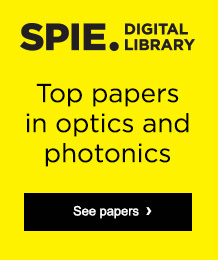Compressed Sensing Tutorial
Popular tutorial in Optical Engineering helps engineers reconstruct images
 To those who have not wrestled with the highly mathematical roots of compressed sensing, or compressive sampling (CS), theory, CS appears to go against years of deeply ingrained engineering intuition: Full reconstruction of images is possible with significantly fewer samples than allowed by the Nyquist sampling theorem.
To those who have not wrestled with the highly mathematical roots of compressed sensing, or compressive sampling (CS), theory, CS appears to go against years of deeply ingrained engineering intuition: Full reconstruction of images is possible with significantly fewer samples than allowed by the Nyquist sampling theorem.
This seeming contradiction is one of the main reasons I believe imaging researchers should study CS; some of the deeper truths of sampling may be missing from your toolset.
Rebecca Willett of Duke University, an early researcher in this field, and co-authors Roummel Marcia of University of California, Merced, and Jonathan Nichols from the U.S. Naval Research Lab have provided the imaging-sensor community with an excellent open-access tutorial on the subject from the perspective of practical optical-imaging systems.
Their Optical Engineering paper “Compressed sensing for practical optical imaging systems: a tutorial,” has particular implications for the design of IR optical-imaging devices. The paper begins by orienting the readers’ intuition regarding how compressive sensing works, noting the fact that we routinely use loss-less compression on images that we store. The fact that images often compress significantly indicates redundant information exists and more efficient acquisition of the data might be possible. This intuition is then reinforced with a short exposition of the main theoretical results from compressive sensing.
These theoretical results are easier to grasp through an examination of many of the existing imaging and spectral instruments researchers have used to demonstrate the utility of CS. These instruments demonstrate image-domain and Fourier-domain sampling/encoding techniques that make use of fixed masks and spatial-light modulators. The authors discuss the advantages and disadvantages of each approach.
The Optical Engineering paper then surveys methods used for reconstruction of the image (a significant consideration for any CS system) and points out the challenges associated with reconstruction of optical images.
These challenges are primarily the size of images (often greater than 1 megapixel), non-negativity of optical intensity based signals, and photon noise. Video reconstruction is also discussed and the commonalities of CS and super-resolution reconstruction noted.
The authors conclude with applications of coded aperture CS techniques to large-format IR imaging systems in both-single-frame and video modes.
This tutorial provides an excellent starting point for gaining a basic understanding of CS as applied to optical imaging and contains excellent references for further study.
 The open-access tutorial aimed at introducing optical engineers to several theoretical advances and practical challenges associated with compressed sensing in optical systems has appeared several times on the monthly “Top 10” download list for Optical Engineering, an SPIE journal on R&D in optical science, engineering, and technology.
The open-access tutorial aimed at introducing optical engineers to several theoretical advances and practical challenges associated with compressed sensing in optical systems has appeared several times on the monthly “Top 10” download list for Optical Engineering, an SPIE journal on R&D in optical science, engineering, and technology.
Through proof-of-concept experiments with a bar target and with video in SWIR systems, American researchers demonstrate how to use compressed sensing, or compressive sampling, concepts to improve contrast and resolution in practical optical imaging settings.
View the current list of popular papers in Optical Engineering: opticalengineering.spiedigitallibrary.org
The recommended paper is Optical Engineering 50(7), 072601 (2011). doi:10.1117/1.3596602 (ow.ly/fSU7g).
–Eddie Jacobs is a member of Optical Engineering editorial board.
- Have a question or comment about this article? Write to us at spieprofessional@spie.org.
- To receive a print copy of SPIE Professional, the SPIE member magazine, become an SPIE member.



